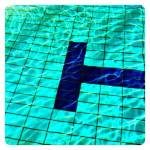Taken from Bodil Johansson ’s blog


Have you thought on that the selection at the end of a swimming pool looks like a T or that a round pot from above becomes an O or that from a certain angle the cycle path marking becomes a Q? All you need is to look closer, change directions and suddenly you see the letter.
This is an exercise that is about learning to see the motives and how you, by thinking about the image composition, that is, how the different parts of the picture are connected, bring out the message of the image.
In addition to training in recognizing and naming letters, it can be an introduction to photography that will then give inspiration to more.
Material
- Phone
- Image editing app like VSCO or Snapseed (both free)
Preparations
- Make sure that the battery in the phone is fully charged because it takes a lot of battery power to shoot.
- Clean the camera lens on the smartphone to get clearer images.
- Make sure you have an image editing app installed on your phone .
- Think of a round that you should go and ”find” letters on. Also think about alternatives in case the weather makes you have to be indoors.
- As a teacher , you should familiarize yourself with the latest version of the image editing app.
Arrangement
- Start by telling the children how it is possible to see letters in the city’s architecture. That if they watch and look for letters that are otherwise hidden as store handles or bench supports , they can see them.
- Then talk about how they can compose a picture. In order for the object, the letter, to be visible, what is around is not allowed to take over the background. Finding lines in the architecture that help the eye find the subject.
- Then you go to a photo tour to discover letters along with your phones. Remember to change image angles, take a picture from a frog perspective (low angle of view) and someone from a bird’s-eye view (high angle of view).
- When you are back, image editing can begin. Ask the children to select three pictures each of which they are happy with and which they can then edit in an app. Perhaps the image needs to be mirrored in order for the letter to become visible? Or cropped? Ask them to make different variations of the same image. For example, a color and a black and white variant of the same image. What happens to the subject then? In what variation will the motifs of the image appear best in?
- Put over the finished pictures on a computer so that the children can then tell about their pictures and tell how they thought when they photographed and why they chose that picture. Ask if it is something they would like to do differently and if they experienced any difficulty finding their letters.
To think on
- In order for the object to become as clear as possible, one should go as close as possible to isolate the ”letter” from its environment.
- . If it’s not fun, it’s wrong.
